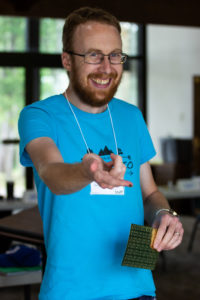This post came from the Aestiva Solutions quarterly newsletter, the Campfire. To subscribe, click here.
This summer, Eric and Ruth found time for a little professional reading as they prepared to host summer camp for instruction and reference librarians. Their favorite item from the stack was a book by the Himmeles called Total Participation Techniques. The idea behind total participation techniques or TPTs is that while you are teaching, instead of calling on the one or two students who raise their hands, all students take time to individually respond to a prompt you share. Then, they share their responses in small groups and then with the class, with the goal of engaging all students while not intimidating them.
While you are probably familiar with several of the techniques presented (think/pair share, anyone?), we found several that were new to us that we are excited to try out this fall in the classroom.
One of Eric’s favorite TPT activities is the line-up:
- Eric prepares a list of discussion questions (one per every two students), then splits the class into half.
- One half forms an inside circle while the other half forms an outside circle.
- The students from each circle form pairs, and Eric gives each pair a discussion question. The pairs talk for two to three minutes then Eric rings an alarm on his phone.
- He then asks the students of one circle to move to their left, while passing their discussion question to the right.
- Then Eric has the students repeat the discussion with a new question and new partner. During all this Eric walks around the circles and listens to the conversations.
- At the end of this activity, Eric concludes with a whole group discussion based off of the conversations that he overheard.
Eric enjoys this activity for a variety of reasons. One, it allows the students to move around and remain active. Two, it forces students to engage with a variety of discussion questions and a variety of classmates. Three, it provides formative assessment for Eric as he continues with the lesson for the day, and allows him the chance to make any important pivots in instruction.

One exercise that Ruth is excited to try out this fall is called IQ cards. This consists of the following steps:
At the end of your lesson, pass out index cards.
- Ask the students to write down one insight they learned and one question they still have.
- Then, have the students stand in a circle and pass the cards a few times without reading them.
- Once they’ve been passed around a bit, then have the students read the card they are holding.
- Then, ask them to start passing them again and this time read them and watch for their own.
- Once they have their own card, they can sit back down and write their names on the back of the cards.
- Then, as a class, you should discuss the common insights and questions the class had, and you can collect the cards if desired.
Ruth has done assessment with index cards before but appreciates these active learning twists to her previous work.
Looking for additional teaching tips as you head into classrooms this fall? Aestiva Solutions is here to support you along the way. Consider bringing us aboard to help your staff with training or retreats in forms that meet your needs and budget.
